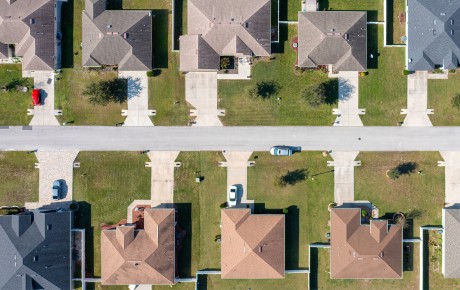
Risk Rating 2.0: levelling up US flood risk
A change in rating methodology for the NFIP could provide greater opportunities for the private flood insurance market.
After introducing Risk Rating 2.0 for all new flood insurance policies on the 1 October 2021, the National Flood Insurance Programme (NFIP) – the US federally backed flood programme – will complete the job this April with all remaining customers moving to the new rating methodology. By, as the NFIP’s administrator the Federal Emergency Management Agency (FEMA) says, “incorporating private sector data sets, catastrophe models and evolving actuarial science” into its risk approach, the NFIP will become more closely aligned with the rating methodologies used by private flood insurers.
It’s a move broadly welcomed by the wider flood insurance industry says Daniel Alpay, Flood Line Underwriter for Hiscox London Market. “For the private flood insurance market this can only be a good thing, helping to build trust in flood insurance providers beyond the NFIP. That said, there is much more that both the NFIP and private market can do together to raise awareness of flood risk amongst both homeowners, brokers and agents given the nationally low take-up rate in the US.”
“For the private flood insurance market this can only be a good thing, helping to build trust in flood insurance providers beyond the NFIP. That said, there is much more that both the NFIP and private market can do together to raise awareness of flood risk amongst both homeowners, brokers and agents given the nationally low take-up rate in the US.” says Alpay.
Losses and rating inequities
Fuelled by years of NFIP losses and rating inequities that, as FEMA states, means “policyholders with lower-valued homes are paying more than their share of the risk while policyholders with higher-valued homes are paying less than their share of the risk”, Risk Rating 2.0 will result in a flood risk that can be more accurately tailored to each property. “The methodology leverages industry best practices and cutting-edge technology to…deliver rates,” adds FEMA, “that are actuarily sound, equitable, easier to understand and better reflect a property’s flood risk.”
It’s a change that’s long overdue says John Dickson – President of Aon Edge Insurance Agency: “The federal programme has been rating flood insurance in the same way for the last 30-40 years…using flood maps that in some instances are decades out of date. I think they have a number of limitations on rate changes that have created unintended consequences with respect to homeowner behaviour, meaning these rates in some cases incentivise people to build homes in areas where homes don’t belong because of the flood risk.”
Second time lucky?
Sceptics of the reform however, might be tempted to point out that this is not the first time that the NFIP has tried to move its rating methodology to better reflect the flood risk it underwrites. Back in 2012, the Biggert-Waters Flood Insurance Reform Act attempted to do exactly that by moving towards ‘full risk’ actuarial rates, but two years later the Homeowner Flood Insurance Affordability Act of 2014 reversed many of the changes.
Point of no return
Why then should Risk Rating 2.0 be any different? “The NFIP has made a big investment in the data they need for every area in which they’ll quote a flood risk as they move towards the rating methodology used by the private flood insurance market,” says Alpay. “Arguably they have gone too far down the road to reverse the changes and there is no real appetite within government to do that given the US$20 billion plus debt pile the NFIP has amassed. They could still soften the impact of the rate changes at some stage, but we’ll have to wait and see.”
"The NFIP has made a big investment in the data they need for every area in which they’ll quote a flood risk as they move towards the rating methodology used by the private flood insurance market" says Alpay.
While the industry waits for the majority of the NFIP’s book to move to the new rating methodology in April to assess the overall impact of Risk Rating 2.0, Alpay has already seen average rate increases of 10% on NFIP policies, although there have been “huge swings” either way on individual risks; a view echoed by Aon’s Dickson. “In some situations, we’ve seen people who were paying low prices, then pay even lower prices, while for others we’ve seen prices going up in multiples. We had a renewal the other day where the homeowner was previously paying US$1700 under the old NFIP rating methodology; one of our private flood programmes priced that risk at US$2500 in premium, whereas Risk Rating 2.0 priced it at nearly US$9,000.”
Despite the volatility, Alpay believes the long-term impact of the change will be a move towards a more equitable flood insurance market, whether cover comes from the NFIP or a private flood provider. “Because the NFIP is using a very similar rating methodology, agents, brokers and consumers are likely to have greater trust in the private market, and be more inclined to shop around for the rate and cover that best suits their risk.”
Greater Flood awareness
There could also be a knock-on effect from more homeowners choosing to buy flood cover for the first time leading to a growth in the overall flood insurance market. “In Flood Zone X for example, where the flood risk is low and homeowners aren’t mandated to buy flood cover by their federally backed mortgage provider, there might be a greater appetite for flood protection if the NFIP rate closely reflects the minimal risk of flood and the process of buying cover is much easier, which it will be given the drastically reduced question set,” says Alpay. In turn, he adds, that is likely to lead to more people comparing the available cover with the private market. “With the NFIP simpler and potentially cheaper for ‘low risk’ properties, it means that they and in turn the private market are likely to get more interest from people who have never considered buying flood insurance before.”
There will be pricing dislocation, adds Dickson, which means “people will be interested in what the private flood market can offer which is really exciting for our industry. Risk Rating 2.0 is making a great advancement in how the federal programme is priced but it won't always be the best option for every individual's specific needs. That's where agents and brokers will be best served by making sure that they have multiple places to go to fulfil their customers' needs."



